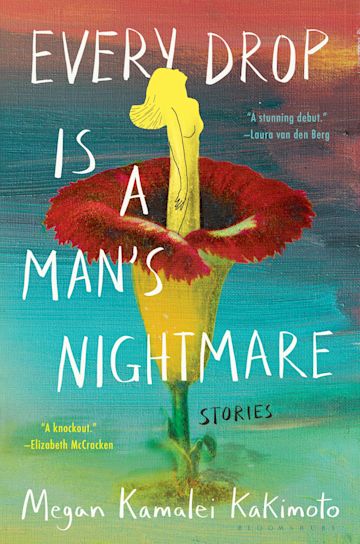Every Drop Is a Man’s Nightmare: Stories
- By Megan Kamalei Kakimoto
- Bloomsbury Publishing
- 272 pp.
- Reviewed by Molly McGinnis
- November 3, 2023
This debut collection is a rich tapestry of occupation, resistance, and Hawaiian identity.

It would be fitting but too simple to call this collection haunting. The stories in Megan Kamalei Kakimoto’s Every Drop Is a Man’s Nightmare are so lavishly imagined, and their characters — from young women to mythical beings to watchful ancestors and even Hawaii itself — are so defiant, that to offer any solid definitions seems like a betrayal of the book’s ethics. Here, boundaries between the past and present, the living and the dead, are not so much flimsy as nonexistent.
The first story, “A Catalogue of Kānaka Superstitions, as Told by Your Mother,” is full of old wisdom and reminiscent of Jamaica Kincaid’s 1978 short story “Girl.” Both comprise directives issued by a mother to an unruly daughter; the mother in Kakimoto’s catalog, however, isn’t as concerned about society’s judgment as she is about her daughter’s ability to irritate and disrespect the dead. It’s a clever way to open the book, and it sets the tone for the tensions in the next 10 stories.
In the titular offering, “Every Drop Is a Man’s Nightmare,” a young girl’s simple mistake — she carries leftover pork home from a party, angering a creature who’s half man, half pig — hurls her into a lifelong curse. But how could she have known? As one elder bemoans, “No one tells the old tales anymore.” This plea to share those legends is a challenge almost to Kakimoto herself, and she faces it head-on.
“Story of Men” features a member of the mythological Menehune race who comes to stay with a family. She is strange but not unwelcome. Here, Kakimoto offers subtle nods to colonialism and the values of a culture that does not seek to dominate others. The girls in the home speak to the guest: “You’re welcome to stay, but please, do not hurt us.” The being’s presence remains unsettling, but she honors the request.
Themes of womanhood and sexuality serve as a throughline in the collection. In one of the more overtly political stories, “Temporary Dwellers,” a teenage girl observes the U.S. military’s use of Hawaii as a strike site for training exercises. Meanwhile, she falls in love with her new roommate, a girl who has fled the bombing of Kaua’i. Rather than a typical coming-of-age or coming-out story, this tale delves deeply into mystery. The teens have no desire for the approval of a world they themselves do not approve of. In a rare moment of unambiguity, Kakimoto writes:
“I think of all the words that have been used to describe the Kaua’i coalition, its members still intent on taking back their land: empowered, irrational, organized, mysterious, embittered, vindictive, dangerous. Then I think of all the words I would use to describe this girl beside me, and the words don’t change.”
Those words could describe most of the women in these pages. In “Madwomen,” “Ms. Amelia’s Salon for Women in Charge,” “Hotel Molokai,” and “Aiko, the Writer,” female protagonists project an awareness of the forces that work for (and often against) them without falling into the tropes of the self-conscious, introspective damsel that so frequently appear in literary fiction. Threads of occupation and the influence of whiteness — “Don’t bother with accessibility,” Aiko the writer’s grandmother tells her. “Even when you write white, the white readers won’t make sense of it…” — are present, but only as shadows on the periphery of much older tales. And they’re no match for these characters or their ancestors; Kakimoto makes sure of that.
The rest of the stories feature curious office managers, family secrets as instruments of power, and, finally, in “The Love and Decline of the Corpse Flower,” a bloom of “intolerable fragrance.” That flower, framed by a tale of loss and love, echoes the phantom blossoms of the opening story. “No matter that we don’t keep flowers here,” says the mother in the latter tale, “the smell stay from the other side.”
Kakimoto’s writing carries a similar power. Even after one closes the book, the power of these stories remains.
Molly McGinnis works as a program coordinator at George Washington University. Her writing has been featured in Guernica, CQ Researcher, Poet Lore, Hobart, and elsewhere. She lives in Washington, DC.
_80_121.png)
